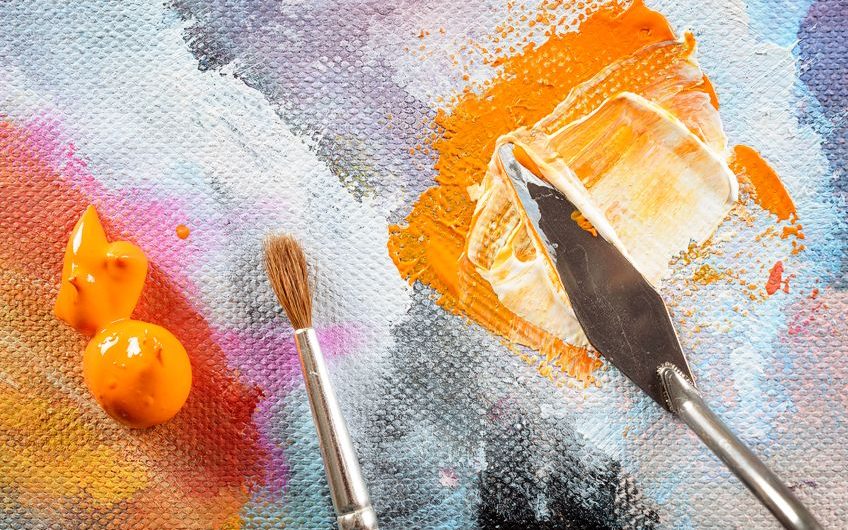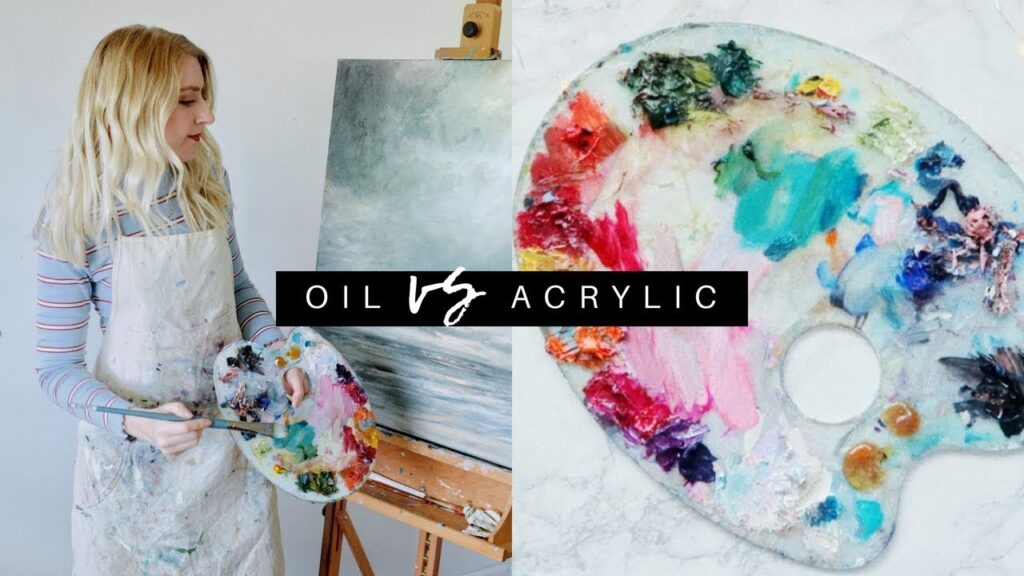Can you mix oil and acrylic paint
When working on various DIY or creative endeavours, folks often question, “Can oil and acrylic paint be combined?” Blending acrylic and oil paintings is frequently tempting since each medium has attributes the artist wants to communicate.
Mixing oil and acrylic paint is inappropriate. Due to the absence of oil in acrylic, the two paints do not blend properly. In addition, the different drying times and other characteristics may result in undesirable results, such as peeling and cracking, as the paint dries.
However, this does not imply that blending acrylic and oil paint is impossible or making the acrylic act more like oil paint. If you’re inquisitive and wondering if oil and acrylic can be combined, here’s everything you need to know.
Can Acrylic and oil paints be mixed?
The bases of two paints often influence whether they may be mixed. Usually, it is simple to mix two colours whose bases are the same. Incompatible bases will not combine effectively.
Acrylic paint is often water-based, although some people call it chemical-based. Oil paint is oil-based.
Even with paint-mixing equipment, it is impossible to blend the two hues since their bases are distinct. No matter how much you mix or swirl oil paints, they will not dissolve in water because oil is hydrophobic.
Although oil and acrylic paint may be mixed, their fundamental differences preclude them from being combined. Moreover, even if the dispersion is initially uniform, it will not stay so permanently. Instead, the two paints separate over time, generating acrylic and oil paint layers inside the container.

The one exception is water-soluble oil paints. Because this kind is designed to combine with water, it might also mix with acrylic. Before painting a large area or incorporating it into an artwork, you may want to do tests.
What Happens When Oil and Acrylic Paints Are Mixed?
The most that can be hoped for when combining oil and acrylic paint is a roughly even distribution of the two colours inside the container since they will not connect. When attempting to paint using the combo, issues often arise.
Due to the varying drying times of the two types of paint, unusual dripping or spreading patterns might be seen. Other possible problems include bubbling, cracking, flaking, peeling, and discolouration, but these may not be immediately apparent. Occasionally, issues arise when the paint starts to dry. Sometimes, it will cause the painted surface to degrade over time.
Some artists profit from the resulting problems. They might deliberately employ an oil and acrylic combination to give the surface (or a piece of the cover) of a painting a cracked or flaking look. After achieving their objective, they enclose the area to prevent the issue from spreading.
Can oil paint be applied over acrylic?
Although acrylic and oil cannot be mixed, acrylic may be painted over. A surface coated with acrylic paint may be painted with oil paint without difficulty. However, the acrylic underneath must be well dry. Acrylic often dries in a few minutes to a few hours, so this is not a significant issue.
Likewise, the same holds with sealants. Applying an oil-based sealant over acrylic paint is possible since it will adhere to the acrylic surface. Certain oil-based varnishes and polyurethanes may fade or acquire a yellowish hue with time, altering the original look of the object.
Can oil paint be painted over acrylic?
Oil paint cannot be applied over acrylic, although acrylic may be painted over oil paint. Even after the oil paint is dry, acrylic paint will not cling to the surface properly. As a result, paint that has been applied may leak, smear, flake, or crack as it dries or ages, among other issues.
In most cases, oil paint should not be sealed with a water-based solution. It will not adhere effectively if the surface is not appropriately prepped, such as by deglossing it.
Numerous deglossing procedures have the potential to alter the colour and texture of the underlying paint, rendering them unsuitable for artistic use. In addition, specific deglossing procedures may be excessively harsh or brutal to paint over on canvases.
However, without deglossing, issues like bubbling, peeling and cracking may develop. To minimize deglossing, it is advisable to avoid putting water-based sealers over oil paint.

How Acrylic Paint Can Appear and Perform Like Oil Paint
Many artists use oils due to their final look and application properties. Acrylics may make it difficult to get a rich colour depth, but oils make it possible. Additionally, blending and mixing oil paints may provide opportunities that would otherwise be impossible to seize because of their prolonged drying times.
However, because oil paint is harder to clean and dries considerably more slowly than acrylic, many people choose an acrylic. In addition, they often attempt to discover ways to make acrylic behave and seem like oil. checkout ways to clean oil paint from brushes without thinner for reusing the brushes later.
Certain products and processes may yield qualities similar to acrylic oil. Find a highly pigmented acrylic paint first. In this technique, you may get the colour intensity that is often only achievable with oil.
Although it is important not to overdo it, applying sufficient paint for each layer is also beneficial. When the paint is not too thin, it will take longer to dry, giving you more time to blend while the painting is still wet.
It is advisable to pick slow-drying acrylics or the proper medium for a traditional acrylic. For instance, an acrylic gel may be used to enhance thickness. Additionally, it will extend drying time and improve shine.
Adding a gloss medium or impasto paste may impart oil-like qualities to acrylic. A medium with a high rate of flow is identical.
Glazing may heighten colours and provide a more lively atmosphere to a painting. You may use them to give a finishing layer to the whole piece of artwork or to specific areas to give depth to the design.
Can Acrylics and Other Paints Be Mixed?
Acrylic paint is compatible with all water-based paints. In addition to other acrylic paints, they may be blended with latex paint or watercolours, for example.
It may also be feasible to combine acrylic with water-soluble oil-based paint. To guarantee a satisfactory conclusion, you may choose to conduct testing. The intention behind the development of water-thinkable oil-based paint was to enable the use of oil paint. A test is suggested as it was not meant for water-based paints such as acrylic.
Acrylic may be challenging to mix with other acrylic paints or water-based paints. If you want a homogenous mixture, take your time mixing it since it does not blend as quickly as two oil-based paints.
In addition, while acrylic paints from different manufacturers may be used, the results often have an impact beyond the colour. Remember that each brand may have a unique texture, so you may adapt your painting method as needed.
Can oil paints be used with other paint types?
In most cases, oil paint can only be mixed with other oil paint since it is incompatible with different varieties. The one exception is water-soluble oil-based paint. If so, it may be compatible with water-based paints such as watercolour, acrylic, and latex.
Knowing that you may mix different kinds of oil-based paint is essential. However, the blended version may have somewhat different properties than the original paints, giving it a unique look or texture. If you know this possibility, you may adapt your plan as needed.
Which is superior: oil or acrylic paint?
Technically, neither oil nor acrylic is the superior medium. Each kind of paint has specific characteristics. To pick the suitable colour for your purposes, you must thus consider your preferences and objectives.
Acrylic paint offers several benefits. The primary advantage is that it is easier to clean up than oil. Likewise, the drying time for acrylic is often between a few minutes to an hour.
In some instances, the quicker drying time might be helpful. If you wish to pause while working on the project or paint slowly, you may find it frustrating if the acrylic dries before you finish. In addition, it suggests that you clean your brushes immediately to avoid the paint from drying on them beforehand.
Moreover, even though acrylic paints have vibrant hues, they often dry darker. As a result, it may be difficult to predict the final colour while applying paint.
When the oil paint is wet, the colours are more accurate and have more colour depth, making it easier to predict the finished product before it has entirely dried. Additionally, blending two oil paints is often easier than mixing two acrylics. Additionally, it is simple to mix while working.

Conclusion
They will not mix well since they have different bases, which may result in peeling or cracking. However, this does not exclude combining the two for a single project or using acrylic paint to approximate the qualities of the oil.
FAQ
-
How is oil paint converted from acrylic paint?
To mix acrylics like oils, use delayed drying acrylics or added a retarder to your favourite type of acrylic paint. By adding acrylic gel to the colour, it is possible to make acrylics as glossy and thick as oils. Acquiring the look of an oil painting using acrylics requires a flair for accurate colour blending.
-
Can baby oil and acrylic paint be combined?
Water-based paints such as acrylic, tempera, gouache, and watercolours may often be mixed safely, although oil- and water-based paints are never mixed in traditional painting.
-
Which painting medium is more straightforward: oil or acrylic?
According to today’s debate, both mediums are appropriate for beginners. However, acrylics are the most straightforward alternative. When you are just beginning to paint, acrylics let you investigate and experiment with your colours, techniques, and painting style.
-
Are oil paints preferable to acrylic paints?
Water-based acrylics dry quickly; however, they do not last as long as oils. Oil paints need some time to dry, but if kept correctly and out of direct sunlight, they may last for decades.

Being associated with art and craft field since decades as a hobbyist and life long learner has given me an opportunity to learn many new things related to art, craft, paints and pottery which i am trying to share with your guys on this website. I have expertise of being professional painter and potter for the last 20+ years
I have learned mind blowing cool tips and insights which makes me a person with ability to improvise and come up with creative ideas and solutions to make stunning and impeccable art pieces of all types which are adored by people across the globe on this website and other platform.


